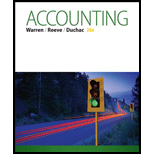
Concept explainers
1.
It is that form of organization which is owned and managed by two or more persons who invest and share the
To record: The
1.
Answer to Problem 12.4APR
The journal entries as of June 30 is as follows:
| Date | Account Titles and Explanation | Debit ($) | Credit ($) | |
| June | 30 | Asset Revaluations | $2,900 | |
| Accounts Receivable | $2,500 | |||
| Allowance for Doubtful Accounts (1) | $400 | |||
| (To record the loss on revaluation of assets.) | ||||
| 30 | Merchandise Inventory | $4,600 | ||
| Asset Revaluations (2) | $4,600 | |||
| (To record the profit on revaluation of merchandise inventory.) | ||||
| 30 | $43,100 | |||
| Equipment (3) | $24,800 | |||
| Asset Revaluations | $18,300 | |||
| (To record the profit on revaluation of equipment.) | ||||
| 30 | Asset Revaluations (Revaluation profit) (4) | $20,000 | ||
| M, Capital (1/2) | $10,000 | |||
| H, Capital (1/2) | $10,000 | |||
| (To record the division of revaluation profit between Partner M and H.) | ||||
Table (1)
Explanation of Solution
Working Notes:
Calculation of Allowances for Doubtful Accounts –
Allowance for doubtful debt is to be increased to 5% of the remaining account.
Old Balance = $1,600
Calculation of Merchandise Inventory-
Book value of Merchandise Inventory = $72,000
Revalued Merchandise Inventory = $76,600
Calculation of Equipment-
Book value of Merchandise Inventory = $180,500
Revalued Merchandise Inventory = $155,700
Calculation of Revaluation Profit –
2.
To record: The additional journal entries for the entrance of partner A into the Partnership.
2.
Explanation of Solution
The additional journal entries for the entrance of partner A into the Partnership is as follows:
| Date | Account Titles and Explanation | Debit ($) | Credit ($) | |
| July | 1 | H, Capital | $70,000 | |
| A, Capital | $70,000 | |||
| (To record the purchase of $70,000 of ownership interest of partner H, by partner A.) | ||||
| 1 | Cash | $45,000 | ||
| A, Capital | $45,000 | |||
| (To record the cash brought by partner A to the partnership firm.) | ||||
Table (2)
3.
To prepare: The
3.
Answer to Problem 12.4APR
The balance sheet for the new partnership as of July 1, 2016 is as follows.
| M, H, and A | |||
| Balance Sheet | |||
| July 1, 2016 | |||
| Assets | |||
| Current assets: | |||
| Cash (5) | $53,000 | ||
| Accounts receivable | $40,000 | ||
| Less allowance for doubtful accounts | -$2,000 | $38,000 | |
| Merchandise inventory | $76,600 | ||
| Prepaid insurance | $3,000 | ||
| Total current assets | $170,600 | ||
| Property, plant, and equipment: | |||
| Equipment | $155,700 | ||
| Total assets | $326,300 | ||
| Liabilities | |||
| Current liabilities: | |||
| Accounts payable | $21,300 | ||
| Notes payable | $35,000 | ||
| Total liabilities | $56,300 | ||
| Partners’ Equity | |||
| M, capital (6) | $130,000 | ||
| H, capital (7) | $25,000 | ||
| A, capital | $115,000 | ||
| Total partners’ equity | $270,000 | ||
| Total liabilities and partners’ equity | $326,300 | ||
Table (2)
Explanation of Solution
Working Notes:
Calculation of Cash Balance –
Calculation of Capital Balance of M–
Calculation of Capital Balance of H–
Want to see more full solutions like this?
Chapter 12 Solutions
Bundle: Accounting, Loose-Leaf Version, 26th + LMS Integrated for CengageNOW, 2 terms Printed Access Card
- What is the purpose of adjusting entries in accounting? A) To close the temporary accounts B) To update the financial records at the end of an accounting period C) To prepare the trial balance D) To record transactions that occurred in the following periodarrow_forwardThe total factory overhead for Leicester Manufacturing is budgeted for the year at $756,000. Leicester manufactures two product lines: standard lamps and premium lamps. These products each require 4 direct labor hours to manufacture. Each product is budgeted for 8,000 units of production for the year. Determine the factory overhead allocated per unit for premium lamps using the single plantwide factory overhead rate.arrow_forwardWhich of the following is an example of an intangible asset? A) Buildings B) Patents C) Equipment D) Inventoryexplain.arrow_forward
- If a company has a profit margin of 10%, this means that:A) For every $1 of sales, the company earns $0.10 in profit.B) The company has $0.10 in expenses for every $1 of sales.C) The company’s revenue exceeds its expenses by 10%.D) The company’s assets exceed its liabilities by 10%.arrow_forwardPlease accounting problemarrow_forwardCan you solve this general accounting problem using accurate calculation methods?arrow_forward
 Financial AccountingAccountingISBN:9781337272124Author:Carl Warren, James M. Reeve, Jonathan DuchacPublisher:Cengage Learning
Financial AccountingAccountingISBN:9781337272124Author:Carl Warren, James M. Reeve, Jonathan DuchacPublisher:Cengage Learning Financial AccountingAccountingISBN:9781305088436Author:Carl Warren, Jim Reeve, Jonathan DuchacPublisher:Cengage Learning
Financial AccountingAccountingISBN:9781305088436Author:Carl Warren, Jim Reeve, Jonathan DuchacPublisher:Cengage Learning College Accounting, Chapters 1-27AccountingISBN:9781337794756Author:HEINTZ, James A.Publisher:Cengage Learning,
College Accounting, Chapters 1-27AccountingISBN:9781337794756Author:HEINTZ, James A.Publisher:Cengage Learning,





